
A | B | C | D | E | F | G | H | CH | I | J | K | L | M | N | O | P | Q | R | S | T | U | V | W | X | Y | Z | 0 | 1 | 2 | 3 | 4 | 5 | 6 | 7 | 8 | 9

German (Standard High German: Deutsch, pronounced [dɔʏtʃ] ⓘ)[10] is a West Germanic language in the Indo-European language family, mainly spoken in Western and Central Europe. It is the most widely spoken and official or co-official language in Germany, Austria, Switzerland, Liechtenstein, and the Italian province of South Tyrol. It is also an official language of Luxembourg and Belgium, as well as a recognized national language in Namibia. There further exist notable German-speaking communities in France (Alsace), the Czech Republic (North Bohemia), Poland (Upper Silesia), Slovakia (Košice Region, Spiš, and Hauerland), Denmark (North Schleswig), Romania and Hungary (Sopron).
It is most closely related to other West Germanic languages, namely Afrikaans, Dutch, English, the Frisian languages, Scots. It also contains close similarities in vocabulary to some languages in the North Germanic group, such as Danish, Norwegian, and Swedish. Modern German gradually developed from the Old High German which in turn developed from Proto-Germanic during the Early Middle Ages. German is the second-most widely spoken Germanic and West Germanic language after English, both as a first and a second language.
Today, German is one of the major languages of the world. It is the most spoken native language within the European Union. German is also widely taught as a foreign language, especially in continental Europe (where it is the third most taught foreign language after English and French), and in the United States. The language has been influential in the fields of philosophy, theology, science, and technology. It is the second-most commonly used scientific language [citation needed] and among the most widely used languages on websites. The German-speaking countries are ranked fifth in terms of annual publication of new books, with one-tenth of all books (including e-books) in the world being published in German.
German is an inflected language, with four cases for nouns, pronouns, and adjectives (nominative, accusative, genitive, dative); three genders (masculine, feminine, neuter); and two numbers (singular, plural). It has strong and weak verbs. The majority of its vocabulary derives from the ancient Germanic branch of the Indo-European language family, while a smaller share is partly derived from Latin and Greek, along with fewer words borrowed from French and Modern English. English, however, is the main source of more recent loan words.
German is a pluricentric language; the three standardized variants are German, Austrian, and Swiss Standard German. Standard German is sometimes called High German, which refers to its regional origin. German is also notable for its broad spectrum of dialects, with many varieties existing in Europe and other parts of the world. Some of these non-standard varieties have become recognized and protected by regional or national governments.
Since 2004, heads of state of the German-speaking countries have met every year,[11] and the Council for German Orthography has been the main international body regulating German orthography.
Classification
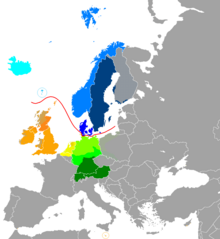
Anglic and North Sea Germanic languages Anglo-Frisian and West Germanic languages
North Sea Germanic and ...... German (High): ...... Yiddish


German is an Indo-European language that belongs to the West Germanic group of the Germanic languages. The Germanic languages are traditionally subdivided into three branches: North Germanic, East Germanic, and West Germanic. The first of these branches survives in modern Danish, Swedish, Norwegian, Faroese, and Icelandic, all of which are descended from Old Norse. The East Germanic languages are now extinct, and Gothic is the only language in this branch which survives in written texts. The West Germanic languages, however, have undergone extensive dialectal subdivision and are now represented in modern languages such as English, German, Dutch, Yiddish, Afrikaans, and others.[12]
Within the West Germanic language dialect continuum, the Benrath and Uerdingen lines (running through Düsseldorf-Benrath and Krefeld-Uerdingen, respectively) serve to distinguish the Germanic dialects that were affected by the High German consonant shift (south of Benrath) from those that were not (north of Uerdingen). The various regional dialects spoken south of these lines are grouped as High German dialects, while those spoken to the north comprise the Low German and Low Franconian dialects. As members of the West Germanic language family, High German, Low German, and Low Franconian have been proposed to be further distinguished historically as Irminonic, Ingvaeonic, and Istvaeonic, respectively. This classification indicates their historical descent from dialects spoken by the Irminones (also known as the Elbe group), Ingvaeones (or North Sea Germanic group), and Istvaeones (or Weser–Rhine group).[12]
Standard German is based on a combination of Thuringian-Upper Saxon and Upper Franconian dialects, which are Central German and Upper German dialects belonging to the High German dialect group. German is therefore closely related to the other languages based on High German dialects, such as Luxembourgish (based on Central Franconian dialects) and Yiddish. Also closely related to Standard German are the Upper German dialects spoken in the southern German-speaking countries, such as Swiss German (Alemannic dialects) and the various Germanic dialects spoken in the French region of Grand Est, such as Alsatian (mainly Alemannic, but also Central–and Upper Franconian dialects) and Lorraine Franconian (Central Franconian).
After these High German dialects, standard German is less closely related to languages based on Low Franconian dialects (e.g., Dutch and Afrikaans), Low German or Low Saxon dialects (spoken in northern Germany and southern Denmark), neither of which underwent the High German consonant shift. As has been noted, the former of these dialect types is Istvaeonic and the latter Ingvaeonic, whereas the High German dialects are all Irminonic; the differences between these languages and standard German are therefore considerable. Also related to German are the Frisian languages—North Frisian (spoken in Nordfriesland), Saterland Frisian (spoken in Saterland), and West Frisian (spoken in Friesland)—as well as the Anglic languages of English and Scots. These Anglo-Frisian dialects did not take part in the High German consonant shift, and the Anglic languages also adopted much vocabulary from both Old Norse and the Norman language.
History
Old High German
The history of the German language begins with the High German consonant shift during the Migration Period, which separated Old High German dialects from Old Saxon. This sound shift involved a drastic change in the pronunciation of both voiced and voiceless stop consonants (b, d, g, and p, t, k, respectively). The primary effects of the shift were the following below.
- Voiceless stops became long (geminated) voiceless fricatives following a vowel;
- Voiceless stops became affricates in word-initial position, or following certain consonants;
- Voiced stops became voiceless in certain phonetic settings.[13]
| Voiceless stop following a vowel |
Word-initial voiceless stop |
Voiced stop |
|---|---|---|
| /p/→/ff/ | /p/→/pf/ | /b/→/p/ |
| /t/→/ss/ | /t/→/ts/ | /d/→/t/ |
| /k/→/xx/ | /k/→/kx/ | /g/→/k/ |

While there is written evidence of the Old High German language in several Elder Futhark inscriptions from as early as the sixth century AD (such as the Pforzen buckle), the Old High German period is generally seen as beginning with the Abrogans (written c. 765–775), a Latin-German glossary supplying over 3,000 Old High German words with their Latin equivalents. After the Abrogans, the first coherent works written in Old High German appear in the ninth century, chief among them being the Muspilli, Merseburg charms, and Hildebrandslied, and other religious texts (the Georgslied, Ludwigslied, Evangelienbuch, and translated hymns and prayers).[14] The Muspilli is a Christian poem written in a Bavarian dialect offering an account of the soul after the Last Judgment, and the Merseburg charms are transcriptions of spells and charms from the pagan Germanic tradition. Of particular interest to scholars, however, has been the Hildebrandslied, a secular epic poem telling the tale of an estranged father and son unknowingly meeting each other in battle. Linguistically, this text is highly interesting due to the mixed use of Old Saxon and Old High German dialects in its composition. The written works of this period stem mainly from the Alamanni, Bavarian, and Thuringian groups, all belonging to the Elbe Germanic group (Irminones), which had settled in what is now southern-central Germany and Austria between the second and sixth centuries, during the great migration.[13]
In general, the surviving texts of Old High German (OHG) show a wide range of dialectal diversity with very little written uniformity. The early written tradition of OHG survived mostly through monasteries and scriptoria as local translations of Latin originals; as a result, the surviving texts are written in highly disparate regional dialects and exhibit significant Latin influence, particularly in vocabulary.[13] At this point monasteries, where most written works were produced, were dominated by Latin, and German saw only occasional use in official and ecclesiastical writing.
Middle High German
While there is no complete agreement over the dates of the Middle High German (MHG) period, it is generally seen as lasting from 1050 to 1350.[15] This was a period of significant expansion of the geographical territory occupied by Germanic tribes, and consequently of the number of German speakers. Whereas during the Old High German period the Germanic tribes extended only as far east as the Elbe and Saale rivers, the MHG period saw a number of these tribes expanding beyond this eastern boundary into Slavic territory (known as the Ostsiedlung). With the increasing wealth and geographic spread of the Germanic groups came greater use of German in the courts of nobles as the standard language of official proceedings and literature.[15] A clear example of this is the mittelhochdeutsche Dichtersprache employed in the Hohenstaufen court in Swabia as a standardized supra-dialectal written language. While these efforts were still regionally bound, German began to be used in place of Latin for certain official purposes, leading to a greater need for regularity in written conventions.
While the major changes of the MHG period were socio-cultural, High German was still undergoing significant linguistic changes in syntax, phonetics, and morphology as well (e.g. diphthongization of certain vowel sounds: hus (OHG & MHG "house")→haus (regionally in later MHG)→Haus (NHG), and weakening of unstressed short vowels to schwa : taga (OHG "days")→tage (MHG)).[16]
A great wealth of texts survives from the MHG period. Significantly, these texts include a number of impressive secular works, such as the Nibelungenlied, an epic poem telling the story of the dragon-slayer Siegfried (c. thirteenth century), and the Iwein, an Arthurian verse poem by Hartmann von Aue (c. 1203), lyric poems, and courtly romances such as Parzival and Tristan. Also noteworthy is the Sachsenspiegel, the first book of laws written in Middle Low German (c. 1220). The abundance and especially the secular character of the literature of the MHG period demonstrate the beginnings of a standardized written form of German, as well as the desire of poets and authors to be understood by individuals on supra-dialectal terms.
The Middle High German period is generally seen as ending when the 1346–53 Black Death decimated Europe's population.[17]
Early New High German
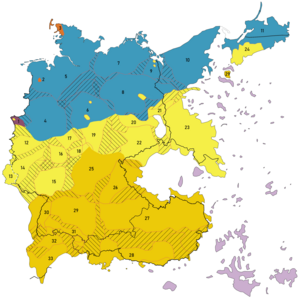
Modern High German begins with the Early New High German (ENHG) period, which Wilhelm Scherer dates 1350–1650, terminating with the end of the Thirty Years' War.[17] This period saw the further displacement of Latin by German as the primary language of courtly proceedings and, increasingly, of literature in the German states. While these states were still part of the Holy Roman Empire, and far from any form of unification, the desire for a cohesive written language that would be understandable across the many German-speaking principalities and kingdoms was stronger than ever. As a spoken language German remained highly fractured throughout this period, with a vast number of often mutually incomprehensible regional dialects being spoken throughout the German states; the invention of the printing press c. 1440 and the publication of Luther's vernacular translation of the Bible in 1534, however, had an immense effect on standardizing German as a supra-dialectal written language.
The ENHG period saw the rise of several important cross-regional forms of chancery German, one being gemeine tiutsch, used in the court of the Holy Roman Emperor Maximilian I, and the other being Meißner Deutsch, used in the Electorate of Saxony in the Duchy of Saxe-Wittenberg.[19]
Alongside these courtly written standards, the invention of the printing press led to the development of a number of printers' languages (Druckersprachen) aimed at making printed material readable and understandable across as many diverse dialects of German as possible.[20] The greater ease of production and increased availability of written texts brought about increased standardisation in the written form of German.

One of the central events in the development of ENHG was the publication of Luther's translation of the Bible into High German (the New Testament was published in 1522; the Old Testament was published in parts and completed in 1534).[21] Luther based his translation primarily on the Meißner Deutsch of Saxony, spending much time among the population of Saxony researching the dialect so as to make the work as natural and accessible to German speakers as possible. Copies of Luther's Bible featured a long list of glosses for each region, translating words which were unknown in the region into the regional dialect. Luther said the following concerning his translation method:
One who would talk German does not ask the Latin how he shall do it; he must ask the mother in the home, the children on the streets, the common man in the market-place and note carefully how they talk, then translate accordingly. They will then understand what is said to them because it is German. When Christ says 'ex abundantia cordis os loquitur,' I would translate, if I followed the papists, aus dem Überflusz des Herzens redet der Mund. But tell me is this talking German? What German understands such stuff? No, the mother in the home and the plain man would say, Wesz das Herz voll ist, des gehet der Mund über.[22]
Luther's translation of the Bible into High German was also decisive for the German language and its evolution from Early New High German to modern Standard German.[21] The publication of Luther's Bible was a decisive moment in the spread of literacy in early modern Germany,[21] and promoted the development of non-local forms of language and exposed all speakers to forms of German from outside their own area.[23] With Luther's rendering of the Bible in the vernacular, German asserted itself against the dominance of Latin as a legitimate language for courtly, literary, and now ecclesiastical subject-matter. His Bible was ubiquitous in the German states: nearly every household possessed a copy.[24] Nevertheless, even with the influence of Luther's Bible as an unofficial written standard, a widely accepted standard for written German did not appear until the middle of the eighteenth century.[25]
Habsburg Empire

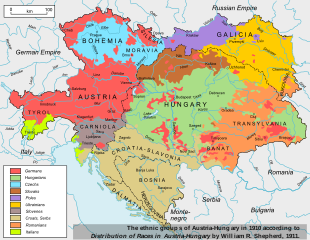
German was the language of commerce and government in the Habsburg Empire, which encompassed a large area of Central and Eastern Europe. Until the mid-nineteenth century, it was essentially the language of townspeople throughout most of the Empire. Its use indicated that the speaker was a merchant or someone from an urban area, regardless of nationality.
Prague (German: Prag) and Budapest (Buda, German: Ofen), to name two examples, were gradually Germanized in the years after their incorporation into the Habsburg domain; others, like Pressburg (Pozsony, now Bratislava), were originally settled during the Habsburg period and were primarily German at that time. Prague, Budapest, Bratislava, and cities like Zagreb (German: Agram) or Ljubljana (German: Laibach), contained significant German minorities.
In the eastern provinces of Banat, Bukovina, and Transylvania (German: Banat, Buchenland, Siebenbürgen), German was the predominant language not only in the larger towns—like Temeschburg (Timișoara), Hermannstadt (Sibiu), and Kronstadt (Brașov)—but also in many smaller localities in the surrounding areas.[26]
Standardization
In 1901, the Second Orthographic Conference ended with a (nearly) complete standardization of the Standard German language in its written form, and the Duden Handbook was declared its standard definition.[27] Punctuation and compound spelling (joined or isolated compounds) were not standardized in the process.

The Deutsche Bühnensprache (lit. 'German stage language') had established conventions for German pronunciation in theatres,[28] three years earlier; however, this was an artificial standard that did not correspond to any traditional spoken dialect. Rather, it was based on the pronunciation of German in Northern Germany, although it was subsequently regarded often as a general prescriptive norm, despite differing pronunciation traditions especially in the Upper-German-speaking regions that still characterise the dialect of the area today – especially the pronunciation of the ending -ig as instead of . In Northern Germany, High German was a foreign language to most inhabitants, whose native dialects were subsets of Low German. It was usually encountered only in writing or formal speech; in fact, most of High German was a written language, not identical to any spoken dialect, throughout the German-speaking area until well into the 19th century. However, wider standardization of pronunciation was established on the basis of public speaking in theatres and the media during the 20th century and documented in pronouncing dictionaries.
Official revisions of some of the rules from 1901 were not issued until the controversial German orthography reform of 1996 was made the official standard by governments of all German-speaking countries.[29] Media and written works are now almost all produced in Standard German which is understood in all areas where German is spoken.
Geographical distribution
Approximate distribution of native German speakers (assuming a rounded total of 95 million) worldwide:
As a result of the German diaspora, as well as the popularity of German taught as a foreign language,[30][31] the geographical distribution of German speakers (or "Germanophones") spans all inhabited continents.
However, an exact, global number of native German speakers is complicated by the existence of several varieties whose status as separate "languages" or "dialects" is disputed for political and linguistic reasons, including quantitatively strong varieties like certain forms of Alemannic and Low German.[9] With the inclusion or exclusion of certain varieties, it is estimated that approximately 90–95 million people speak German as a first language,[32][page needed][33] 10–25 million speak it as a second language,[32][page needed] and 75–100 million as a foreign language.[2] This would imply the existence of approximately 175–220 million German speakers worldwide.[34]
German sociolinguist Ulrich Ammon estimated a number of 289 million German foreign language speakers without clarifying the criteria by which he classified a speaker.[35]
Europe
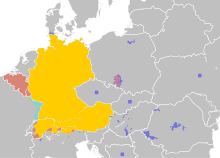

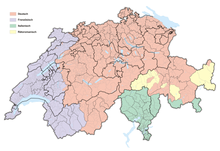
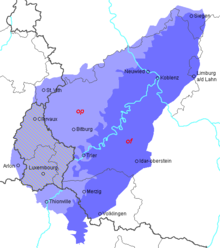
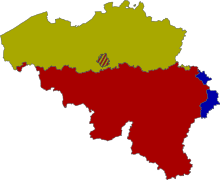
As of 2012[update], about 90 million people, or 16% of the European Union's population, spoke German as their mother tongue, making it the second-most widely spoken language on the continent after Russian and the second biggest language in terms of overall speakers (after English), as well as the most spoken native language.[2]
German Sprachraum
The area in central Europe where the majority of the population speaks German as a first language and has German as a (co-)official language is called the "German Sprachraum". German is the official language of the following countries:
German is a co-official language of the following countries:
- Belgium (as majority language only in the German-speaking Community, which represents 0.7% of the Belgian population)
- Luxembourg, along with French and Luxembourgish
- Switzerland, co-official at the federal level with French, Italian, and Romansh, and at the local level in four cantons: Bern (with French), Fribourg (with French), Grisons (with Italian and Romansh) and Valais (with French)
- Italy, (as majority language only in the Autonomous Province of South Tyrol, which represents 0.6% of the Italian population)
Outside the German Sprachraum
Although expulsions and (forced) assimilation after the two World wars greatly diminished them, minority communities of mostly bilingual German native speakers exist in areas both adjacent to and detached from the Sprachraum.
Within Europe, German is a recognized minority language in the following countries:[36]
- Czech Republic (see also: Germans in the Czech Republic)
- Denmark (see also: North Schleswig Germans)
- Hungary (see also: Germans of Hungary)
- Poland (see also German minority in Poland; German is an auxiliary and co-official language in 31 communes)[37]
- Romania (see also: Germans of Romania)
- Russia[38] (see also: Germans in Russia)
- Slovakia (see also: Carpathian Germans)
In France, the High German varieties of Alsatian and Moselle Franconian are identified as "regional languages", but the European Charter for Regional or Minority Languages of 1998 has not yet been ratified by the government.[39]
Africa
Namibia

Namibia also was a colony of the German Empire, from 1884 to 1915. About 30,000 people still speak German as a native tongue today, mostly descendants of German colonial settlers.[40] The period of German colonialism in Namibia also led to the evolution of a Standard German-based pidgin language called "Namibian Black German", which became a second language for parts of the indigenous population. Although it is nearly extinct today, some older Namibians still have some knowledge of it.[41]
German remained a de facto official language of Namibia after the end of German colonial rule alongside English and Afrikaans, and had de jure co-official status from 1984 until its independence from South Africa in 1990. However, the Namibian government perceived Afrikaans and German as symbols of apartheid and colonialism, and decided English would be the sole official language upon independence, stating that it was a "neutral" language as there were virtually no English native speakers in Namibia at that time.[40] German, Afrikaans, and several indigenous languages thus became "national languages" by law, identifying them as elements of the cultural heritage of the nation and ensuring that the state acknowledged and supported their presence in the country.
Today, Namibia is considered to be the only German-speaking country outside of the Sprachraum in Europe.[42] German is used in a wide variety of spheres throughout the country, especially in business, tourism, and public signage, as well as in education, churches (most notably the German-speaking Evangelical Lutheran Church in Namibia (GELK)), other cultural spheres such as music, and media (such as German language radio programs by the Namibian Broadcasting Corporation). The Allgemeine Zeitung is one of the three biggest newspapers in Namibia and the only German-language daily in Africa.[40]
Rest of Africa
An estimated 12,000 people speak German or a German variety as a first language in South Africa, mostly originating from different waves of immigration during the 19th and 20th centuries.[43] One of the largest communities consists of the speakers of "Nataler Deutsch",[44] a variety of Low German concentrated in and around Wartburg. The South African constitution identifies German as a "commonly used" language and the Pan South African Language Board is obligated to promote and ensure respect for it.[45]
Cameroon was a colony of the German Empire from 1884 to 1916. However, German was replaced by French and English, the languages of the two successor colonial powers, after its loss in World War I. Nevertheless since the 21st century, German has become a popular foreign language among pupils and students, with 300,000 people learning or speaking German in Cameroon in 2010 and over 230,000 in 2020.[46] Today Cameroon is one of the African countries outside Namibia with the highest number of people learning German.[47]
North America
In the United States, German is the fifth most spoken language in terms of native and second language speakers after English, Spanish, French, and Chinese (with figures for Cantonese and Mandarin combined), with over 1 million total speakers.[48] In the states of North Dakota and South Dakota, German is the most common language spoken at home after English.[49] As a legacy of significant German immigration to the country, German geographical names can be found throughout the Midwest region, such as New Ulm and Bismarck (North Dakota's state capital), plus many other regions.[50]
A number of German varieties have developed in the country and are still spoken today, such as Pennsylvania Dutch and Texas German.
South America
In Brazil, the largest concentrations of German speakers are in the states of Rio Grande do Sul (where Riograndenser Hunsrückisch developed), Santa Catarina, and Espírito Santo.[51]
German dialects (namely Hunsrik and East Pomeranian) are recognized languages in the following municipalities in Brazil:
- Espírito Santo (statewide cultural language): Domingos Martins, Laranja da Terra, Pancas, Santa Maria de Jetibá, Vila Pavão[52]
- Rio Grande do Sul (Riograndenser Hunsrückisch German is a designated cultural language in the state): Santa Maria do Herval, Canguçu[53]
- Santa Catarina: Antônio Carlos, Pomerode (standard German recognized)[51]
Small concentrations of German-speakers and their descendants are also found in Argentina, Chile, Paraguay, Venezuela, and Bolivia.[43]
Oceania
In Australia, the state of South Australia experienced a pronounced wave of Prussian immigration in the 1840s (particularly from Silesia region). With the prolonged isolation from other German speakers and contact with Australian English, a unique dialect known as Barossa German developed, spoken predominantly in the Barossa Valley near Adelaide. Usage of German sharply declined with the advent of World War I, due to the prevailing anti-German sentiment in the population and related government action. It continued to be used as a first language into the 20th century, but its use is now limited to a few older speakers.[54]
As of the 2013 census, 36,642 people in New Zealand spoke German, mostly descendants of a small wave of 19th century German immigrants, making it the third most spoken European language after English and French and overall the ninth most spoken language.[55]
A German creole named Unserdeutsch was historically spoken in the former German colony of German New Guinea, modern day Papua New Guinea. It is at a high risk of extinction, with only about 100 speakers remaining, and a topic of interest among linguists seeking to revive interest in the language.[56]
As a foreign language

Like English, French, and Spanish, German has become a standard foreign language throughout the world, especially in the Western World.[2][57] German ranks second on par with French among the best known foreign languages in the European Union (EU) after English,[2] as well as in Russia,[58] and Turkey.[2] In terms of student numbers across all levels of education, German ranks third in the EU (after English and French)[31] and in the United States (after Spanish and French).[30][59] In British schools, where learning a foreign language is not mandatory, a dramatic decline in entries for German A-Level has been observed.[60] In 2020, approximately 15.4 million people were enrolled in learning German across all levels of education worldwide. This number has decreased from a peak of 20.1 million in 2000.[61] Within the EU, not counting countries where it is an official language, German as a foreign language is most popular in Eastern and Northern Europe, namely the Czech Republic, Croatia, Denmark, the Netherlands, Slovakia, Hungary, Slovenia, Sweden, Poland, and Bosnia and Herzegovina.[2][62] German was once, and to some extent still is, a lingua franca in those parts of Europe.[63]
Standard German

The basis of Standard German developed with the Luther Bible and the chancery language spoken by the Saxon court, part of the regional High German group.[64] However, there are places where the traditional regional dialects have been replaced by new vernaculars based on Standard German; that is the case in large stretches of Northern Germany but also in major cities in other parts of the country. It is important to note, however, that the colloquial Standard German differs from the formal written language, especially in grammar and syntax, in which it has been influenced by dialectal speech.
Standard German differs regionally among German-speaking countries in vocabulary and some instances of pronunciation and even grammar and orthography. This variation must not be confused with the variation of local dialects. Even though the national varieties of Standard German are only somewhat influenced by the local dialects, they are very distinct. German is thus considered a pluricentric language, with currently three national standard varieties of German: Standard German German, Standard Austrian German and Standard Swiss German. In comparison to other European languages (e.g. Portuguese, English), the multi-standard character of German is still not widely acknowledged.[65] However, 90% of Austrian secondary school teachers of German consider German has having "more than one" standard variety.[66] In this context, some scholars speak of a One Standard German Axiom that has been maintained as a core assumption of German dialectology.[67]
In most regions, the speakers use a continuum, e.g. "Umgangssprache" (colloquial standards) from more dialectal varieties to more standard varieties depending on the circumstances.
Varietiesedit

In German linguistics, German dialects are distinguished from varieties of Standard German. The varieties of Standard German refer to the different local varieties of the pluricentric German. They differ mainly in lexicon and phonology, but also smaller grammatical differences. In certain regions, they have replaced the traditional German dialects, especially in Northern Germany.
In the German-speaking parts of Switzerland, mixtures of dialect and standard are very seldom used, and the use of Standard German is largely restricted to the written language. About 11% of the Swiss residents speak Standard German at home, but this is mainly due to German immigrants.[69] This situation has been called a medial diglossia. Swiss Standard German is used in the Swiss education system, while Austrian German is officially used in the Austrian education system.
Dialectsedit
The German dialects are the traditional local varieties of the language; many of them are not mutually intelligible with standard German, and they have great differences in lexicon, phonology, and syntax. If a narrow definition of language based on mutual intelligibility is used, many German dialects are considered to be separate languages (for instance by ISO 639-3). However, such a point of view is unusual in German linguistics.
The German dialect continuum is traditionally divided most broadly into High German and Low German, also called Low Saxon. However, historically, High German dialects and Low Saxon/Low German dialects do not belong to the same language. Nevertheless, in today's Germany, Low Saxon/Low German is often perceived as a dialectal variation of Standard German on a functional level even by many native speakers.
The variation among the German dialects is considerable, with often only neighbouring dialects being mutually intelligible. Some dialects are not intelligible to people who know only Standard German. However, all German dialects belong to the dialect continuum of High German and Low Saxon.
Low Germanedit
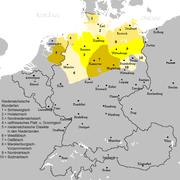
Middle Low German was the lingua franca of the Hanseatic League. It was the predominant language in Northern Germany until the 16th century. In 1534, the Luther Bible was published. It aimed to be understandable to a broad audience and was based mainly on Central and Upper German varieties. The Early New High German language gained more prestige than Low German and became the language of science and literature. Around the same time, the Hanseatic League, a confederation of northern ports, lost its importance as new trade routes to Asia and the Americas were established, and the most powerful German states of that period were located in Middle and Southern Germany.
The 18th and 19th centuries were marked by mass education in Standard German in schools. Gradually, Low German came to be politically viewed as a mere dialect spoken by the uneducated. The proportion of the population who can understand and speak it has decreased continuously since World War II.
- Cities with more than 100,000 inhabitants in the area: most of the Ruhr (Dortmund, Essen, Bochum, Gelsenkirchen, Hagen, Herne, Bottrop, Recklinghausen), Hamburg, Bremen, Hanover, Bielefeld, Münster, Braunschweig, Kiel, Groningen, Lübeck, Rostock, Hamm, Oldenburg, Osnabrück, Enschede, Paderborn, Wolfsburg, Göttingen, Bremerhaven, Salzgitter, Gütersloh, Hildesheim, and historically also Berlin, Halle (Saale), Magdeburg and Potsdam.
Low Franconianedit
The Low Franconian dialects fall within a linguistic category used to classify a number of historical and contemporary West Germanic varieties most closely related to, and including, the Dutch language. Consequently, the vast majority of the Low Franconian dialects are spoken outside of the German language area. Low Franconian dialects are spoken in the Netherlands, Belgium, South Africa, Suriname and Namibia, and along the Lower Rhine in Germany, in North Rhine-Westphalia. The region in Germany encompasses parts of the Rhine-Ruhr metropolitan region and of the Ruhr.
The Low Franconian dialects have three different standard varieties: In the Netherlands, Belgium and Suriname, it is Dutch, which is itself a Low Franconian language. In South Africa, it is Afrikaans, which is also categorized as Low Franconian. During the Middle Ages and Early Modern Period, the Low Franconian dialects now spoken in Germany, used Middle Dutch or Early Modern Dutch as their literary language and Dachsprache. Following a 19th-century change in Prussian language policy, use of Dutch as an official and public language was forbidden; resulting in Standard German taking its place as the region's official language.[70][71] As a result, these dialects are now considered German dialects from a socio-linguistic point of view.[72]
The Low Franconian dialects in Germany are divided by the Uerdingen line (north of which "i" is pronounced as "ik" and south of which as "ich") into northern and southern Low Franconian. The northern variants comprise Kleverlandish, which is most similar to Standard Dutch. The other ones are transitional between Low Franconian and Ripuarian, but closer to Low Franconian.
- Cities with more than 100,000 inhabitants in the area: Cape Town, Pretoria, Brussels,[a] Gqeberha, Amsterdam, Düsseldorf*, Rotterdam, The Hague, Antwerp, Duisburg*, Utrecht, Wuppertal*, Mönchengladbach*, Ghent, Bloemfontein, Eindhoven, Paramaribo, Krefeld*, Almere, Oberhausen*, Tilburg, Nijmegen, Mülheim an der Ruhr*, Arnhem, Haarlem, Amersfoort, Solingen*, Neuss*, Breda, Apeldoorn, Zwolle, Zoetermeer, Leiden, Maastricht, Dordrecht, Bruges, Remscheid*, 's-Hertogenbosch, Delft, Moers*, Leuven, Willemstad, and the south of Essen*.
* city with German as standard language
High Germanedit


(The Rhenish fan)
1. Low Franconian
2. Middle Franconian Dorp–Dorf line dat–das line Appel–Apfel line
3. High Franconian
The High German dialects consist of the Central German, High Franconian and Upper German dialects. The High Franconian dialects are transitional dialects between Central and Upper German. The High German varieties spoken by the Ashkenazi Jews have several unique features and are considered as a separate language, Yiddish, written with the Hebrew alphabet.
Central Germanedit
The Central German dialects are spoken in Central Germany, from Aachen in the west to Görlitz in the east. Modern Standard German is mostly based on Central German dialects.
West Central Germanedit
The West Central German dialects are the Central Franconian dialects (Ripuarian and Moselle Franconian) and the Rhenish Franconian dialects (Hessian and Palatine). These dialects are considered as
- German in Germany and Belgium
- Luxembourgish in Luxembourg
- Lorraine Franconian in Moselle, France
- Alsatian (in a Rhenish Franconian variant) in Alsace bossue, France
- Limburgish or Kerkrade dialect in the Netherlands.
- Transylvanian Saxon in Transylvania, Romania (considered a variant of German)
- Banat Swabian in Banat, Romania (considered a variant of German)
Luxembourgish as well as Transylvanian Saxon and Banat Swabian are based on Moselle Franconian dialects.
- Cities with more than 100,000 inhabitants in the area: Cologne, Frankfurt am Main, Bonn, Mannheim, Wiesbaden, Aachen, Mainz, Kassel, Saarbrücken, Ludwigshafen am Rhein, Leverkusen, Heidelberg, Darmstadt, Offenbach am Main, Luxembourg City, Koblenz, Bergisch Gladbach, Trier, Siegen, Hanau, Kaiserslautern, the south of Düsseldorf, and in Romania: Cluj-Napoca (German: Klausenburg),[b] Timișoara (Temeschburg),[c] Brașov (Kronstadt),[d] Oradea (Großwardein),[e] Arad,[f] Sibiu (Hermannstadt)[g] and Târgu Mureș (Neumarkt am Mieresch).[h]
East Central Germanedit
Further east, the non-Franconian, East Central German dialects are spoken (Thuringian, Upper Saxon, Erzgebirgisch (dialect of the Ore Mountains) and North Upper Saxon–South Markish, and earlier, in the then German-speaking parts of Silesia also Silesian, and in then German southern East Prussia also High Prussian).
- Cities with more than 100,000 inhabitants in the area: Berlin,[i] Leipzig, Dresden, Halle (Saale),[j] Magdeburg,[k] Erfurt, Potsdam,[l] Chemnitz and Jena.
High Franconianedit

The High Franconian dialects are transitional dialects between Central and Upper German. They consist of the East and South Franconian dialects.
East Franconianedit
The East Franconian dialects are spoken in the region of Franconia. Franconia consists of the Bavarian districts of Upper, Middle, and Lower Franconia, the region of South Thuringia (those parts of Thuringia south of the Thuringian Forest), and the eastern parts of the region of Heilbronn-Franken (Tauber Franconia and Hohenlohe) in northeastern Baden-Württemberg. East Franconian is also spoken in most parts of Saxon Vogtland (in the Vogtland District around Plauen, Reichenbach im Vogtland, Auerbach/Vogtl., Oelsnitz/Vogtl. and Klingenthal). East Franconian is colloquially referred to as "Fränkisch" (Franconian) in Franconia (including Bavarian Vogtland), and as "Vogtländisch" (Vogtlandian) in Saxon Vogtland.
Zdroj:https://en.wikipedia.org?pojem=German_language
Text je dostupný za podmienok Creative Commons Attribution/Share-Alike License 3.0 Unported; prípadne za ďalších podmienok. Podrobnejšie informácie nájdete na stránke Podmienky použitia.
Antropológia
Aplikované vedy
Bibliometria
Dejiny vedy
Encyklopédie
Filozofia vedy
Forenzné vedy
Humanitné vedy
Knižničná veda
Kryogenika
Kryptológia
Kulturológia
Literárna veda
Medzidisciplinárne oblasti
Metódy kvantitatívnej analýzy
Metavedy
Metodika
Text je dostupný za podmienok Creative
Commons Attribution/Share-Alike License 3.0 Unported; prípadne za ďalších
podmienok.
Podrobnejšie informácie nájdete na stránke Podmienky
použitia.
www.astronomia.sk | www.biologia.sk | www.botanika.sk | www.dejiny.sk | www.economy.sk | www.elektrotechnika.sk | www.estetika.sk | www.farmakologia.sk | www.filozofia.sk | Fyzika | www.futurologia.sk | www.genetika.sk | www.chemia.sk | www.lingvistika.sk | www.politologia.sk | www.psychologia.sk | www.sexuologia.sk | www.sociologia.sk | www.veda.sk I www.zoologia.sk

